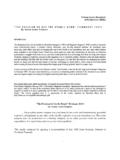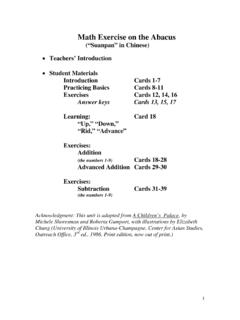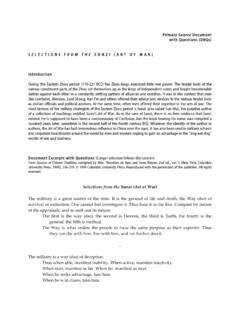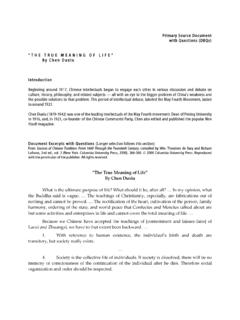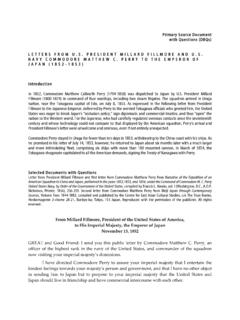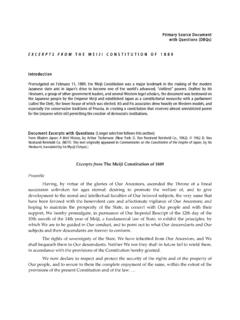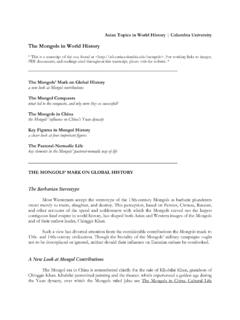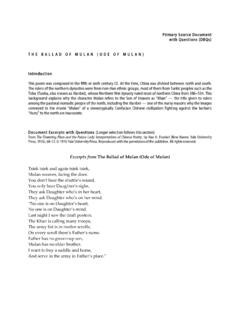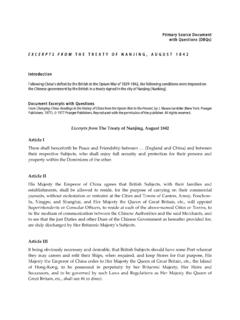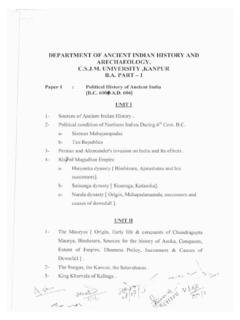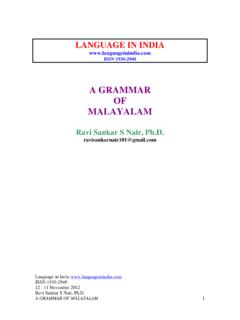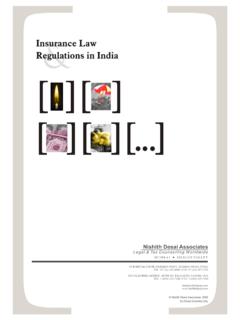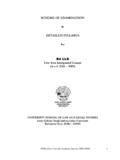Transcription of The Travel Records of Chinese Pilgrims
1 The Travel Records of Chinese Pilgrims Faxian, Xuanzang, and Yijing SOURCES FOR CROSS-CULTURAL ENCOUNTERS. BETWEEN ANCIENT CHINA AND ANCIENT INDIA. By Tansen Sen The statue of Xuanzang at the Great Wild Goose Pagoda in Xi'an, which was built to house the texts he brought back from India. Image source: :Xuanzang_ T. he spread of Buddhist doctrines from India to China beginning sometime in the first century CE triggered a profusion of cross-cultural exchanges that had a profound impact on Asian and world history. The travels of Buddhist monks and Pilgrims and the simultaneous circulation of religious texts and relics not only stimulated interac- tions between the Indian kingdoms and various regions of China, but also influenced people living in Central and Southeast Asia. Indeed, the transmission of Buddhist doctrines from India to China was a complex process that involved multiple societies and a diverse group of people, including missionaries, itinerant traders, artisans, and medical Chinese Pilgrims played a key role in the exchanges between ancient India and ancient China.
2 They introduced new texts and doctrines to the Chinese clergy, carried Buddhist para- phernalia for the performance of rituals and ceremonies, and provided detailed accounts of their spiritual journeys to India. Records of Indian society and its virtuous rulers, accounts of the flourishing monastic institutions, and stories about the magical and miraculous prowess of the Buddha and his disciples often accompanied the descriptions of the pilgrimage sites in their Travel Records . In fact, these Travel Records contributed to the development of a unique perception of India among members of the Chinese clergy. For some, India was a sacred, even Utopian, realm. Others saw India as a mystical land inhabited by civilized and sophisticated people. In the context of Chinese discourse on foreign peoples, who were often described as uncivilized and barbaric, these accounts significantly elevated the Chinese perception of Indian Faxian, Xuanzang, and Yijing were among hundreds of Chinese monks who made pil- grimages to India during the first millennium CE.
3 The detailed accounts of their journeys make them more famous than others. These Travel Records are important historical resources for several reasons. First, they provide meticulous accounts of the nature of Buddhist doc- trines, rituals, and monastic institutions in South, Central, and Southeast Asia. Second, they contain vital information about the social and political conditions in South Asia and king- doms situated on the routes between China and India. Third, they offer remarkable insights into cross-cultural perceptions and interactions. Additionally, these accounts throw light on the arduous nature of long-distance Travel , commercial exchanges, and the relationship between Buddhist Pilgrims and itinerant 24 EDUCATION ABOUT ASIA Volume 11, Number 3 Winter 2006. Teaching About Asia Through Travelers' Tales Faxian (337? 422?) Map 1. Faxian's Itinerary. See Map 2 on page 27. for additional details.
4 F. axian was one of the first and perhaps the oldest Chinese monk to Travel to India. In Map illustration by Willa Davis using Cartesia Map Art for the base map of Asia. 399, when he embarked on his trip from the ancient Chinese capital Chang'an (pre- sent-day Xi'an in Shaanxi province), Faxian was more than sixty years old. By the time he returned fourteen years later, the Chinese monk had trekked across the treacherous Taklamakan desert (in present-day Xinjiang Uyghur Autonomous Region of the People's Republic of China), visited the major Buddhist pilgrimage sites in India, traveled to Sri Lanka, and survived a precarious voyage along the sea route back to China (Map 1).4. The opening passage of Faxian's A Record of the Buddhist Kingdoms tells us that the procurement of texts related to monastic rules ( , Vinaya) was the main purpose of his trip to India. In addition to revealing the intent of his trip, the statement also underscores the need for this crucial Buddhist literature in contemporary China.
5 In the third and fourth cen- turies, a number of important Buddhist texts, including the Lotus Sutra, had been translated into Chinese . Although a few Vinaya texts were available to Faxian, the growing Buddhist community in China was aware of the paucity of these texts essential for the establishment and proper functioning of monastic As he proceeded westward toward India, Faxian encountered the multiethnic societies of Central Asia. In Loulan, for example, he saw people who dressed like the Chinese but followed the customs of India. The local Buddhist clergy, according to him, read Indian books and practiced speaking Indian language. Faxian also describes the famous oasis city 25. Faxian was about 77 years old when he reached the Chinese coast. His A Record of the Buddhist Kingdoms was the first eyewitness account of the Buddhist practices and pilgrimage sites in Central and South Asia written in Chinese .
6 Of Khotan on the southern rim of the Taklamakan as an important Buddhist center in the region. Throughout the country, he writes, the houses of the people stand apart like (sepa- rate) stars, and each family has a small tope ( , pagoda) reared in front of its door. The smallest of these may be twenty cubits high, or rather more. They make (in monasteries). rooms for monks from all quarters, the use of which is given to traveling monks who may arrive, and are provided with whatever else they require. 6. It quickly becomes clear from Faxian's Travel record that he wanted to highlight Buddhist practices at the sites he visited. Thus, his account includes the description of local Buddhist monasteries, the approximate number of Buddhist monks in the region, the teach- ings and rituals practiced by them, and the Buddhist legends associat- ed with some of these sites. Near the city of Taxila (in the present-day northwestern region of Pakistan), for instance, he points out that this was the site where the Buddha, during one of his previous lives, had offered his body to a starving tigress.
7 He describes the conception of the Buddha at Kapilavastu, his birth in a garden in Lumbini, and the attainment of nirvana at Ku sinagara (see Map 2). The veneration of the relics of the Buddha in Central and South Asia is also detailed throughout the narrative. In Peshawar, for instance, the Chinese monk witnessed the rituals associated with the worship of the Buddha's alms-bowl. Then in Sri Lanka, he describes the elaborate ceremony overseen by the local ruler to venerate the Buddha's tooth. These Records of relic veneration contributed to the development of similar ceremonies in China. They also triggered a demand for the bodily remains and other objects associated with the life of kyamuni Buddha. In fact, the demand for Buddhist relics and ritual items in China resulted in the formation of a unique net- work through which Buddhist doctrines and ritual items circulated between South and East Asia. This network also fostered a relation- ship of mutual benefit for Buddhist monks and itinerant traders.
8 While Buddhist monks often hitchhiked on merchant caravans or ships, long-distance traders profited from the creation of new demands for commodities associated with Buddhist rituals. Further- more, Buddhist monasteries provided accommodation and health care to the long-distance traders, many of whom reciprocated by giv- ing donations to the monastic Sometime in 408 or 409, Faxian reportedly traveled on a mercantile ship from the port of Tamralipti, in eastern India, to Sri Lanka. After about two years' stay at the island, Faxian again boarded a seagoing vessel to return to China through Southeast Asia. Faxian's narrative of his voyage on the mercantile vessels, albeit marked by near-catastrophic experiences due to the ravages of the sea, demonstrates the above-mentioned relationship between Bud- dhist monks and itinerant traders as well as the existence of maritime A modern-day rendition of the monk Faxian.
9 Trading channels linking the coastal regions of India and China. It is also evident from Image source: Faxian's account that maritime Travel between southern Asia and China was perilous and the navigational techniques extremely rudimentary. Faxian was about 77 years old when he reached the Chinese coast. His A Record of the Buddhist Kingdoms was the first eyewitness account of the Buddhist practices and pilgrim- age sites in Central and South Asia written in Chinese . It was no doubt immensely popular 26 EDUCATION ABOUT ASIA Volume 11, Number 3 Winter 2006. Teaching About Asia Through Travelers' Tales THE GANGES RIVER BASIN. Indraprastha (Delhi). Ahicchatra Kampilya Kapilavastu Samkasya Mathura Lumbini Sa Sravasti Ya ray Virat mu Papa uR. na Ri ve Kusinagara ive Ga r Ac r ng Ayodhya ir Ga av es nd ati ak Ri Ri Ri ve ve G. ve r r om r at i Vaisali Prayaga (Allahabad) Sarnath Pataliputra Nalanda Kausambi Varanasi Campa Rajgir Vulture Bodh Peak Gaya Map 2.
10 The Ganges basin and the Buddhist pilgrimage sites in India. Illustration by Willa Davis. among the contemporary Chinese clergy, many of whom considered India as a holy land. This unique perception of India among the members of the Chinese clergy and their feeling of melancholy because they lived in the borderland, far removed from the sites frequented by the Buddha, can be discerned in Faxian's Daozheng, one of the Chinese monks who accompanied Faxian, was so moved by the Buddhist sites and monastic institutions in India that he decided not to return to China. From now until I attain Buddhahood, . Daozheng is supposed to have remarked, I wish that I not be reborn in the borderland. 9. Faxian's account seems to have contributed to the formation of the Chinese perception of India as a sophisticated and culturally advanced society. In the sixth century, Li Daoyuan (d. 527) in his commentary on the third-century work Shui jing (The Water Classic) gives the following account of Middle India (referred to as Madhyade sa )10 based on Faxian's A Record of the Buddhist Kingdoms: From here ( , Mathura) to the south all [the country] is Middle India (Mad- hyade sa).
